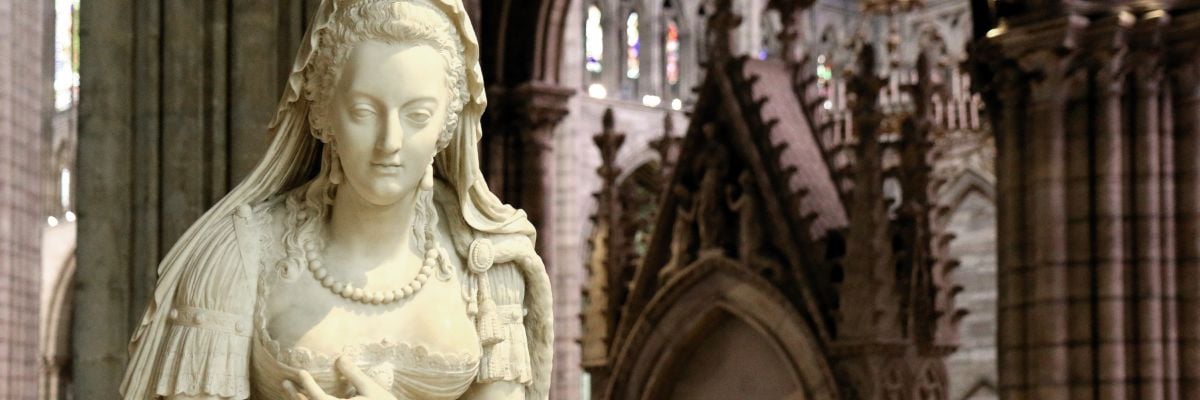
On June 11, 1144, the famous Abbot Suger of St.-Denis welcomed a grand assembly. King Louis VII of France, fourteen bishops, five archbishops, and knights and nobility from across France attended the formal consecration of the altars of the restored abbey church of St. Denis in southern France. As choirs chanted, King Louis stood with twelve of his knights in honor of Christ and the apostles as the gathered bishops performed the ceremony.
The new abbey of St.-Denis was an architectural and artistic masterpiece the likes of which had never been seen before. As though miraculously, the abbey church was bathed in a stunning, even light that poured in through expansive, luminous stained glass windows—so unlike the tiny windows and massive block walls the assembled dignitaries were used to. This new design of St.-Denis marked not only a personal triumph for Suger but the advent of the Gothic architecture that would become a lasting symbol of medieval Christian civilization. The Gothic style spread rapidly through France and England (although in Germany the earlier and heavier Romanesque style long remained the favorite form). Once firmly established, though, Gothic architecture held sway as the physical embodiment of its age until the sixteenth century, when it was gradually replaced by the art of the Renaissance.
Cathedrals are one of the most distinct achievements of the Catholic Church. These grand edifices of the Catholic faith stand in cities all over the world. The great Gothic cathedrals were the foremost manifestations—architecturally, culturally, artistically, and liturgically—of the grand.aspirations of the Age of Faith. The cathedral was at the center of civic life, both geographically and spiritually. They are an expression of the ecclesiastical life of medieval Christians and a physical demonstration of the theological priorities of the time. To this day, the Gothic cathedral remains a prominent and symbolic feature of Christianity as it was in centuries past.
The Place of the Cathedral in Medieval Life
The place of the cathedral in Christian culture was established long before the Middle Ages. It originated as a particular church of the bishop. Once differentiated from the other churches, the cathedralis emerged as the place of worship that was also attended by the gradually emerging episcopal curia (or supporting court) of the bishop, whose powers increased steadily as those of the civic authorities declined. This trend was first established when Emperor Constantine the Great (306–337) gave his palace of the Lateran to Pope Sylvester I to serve as the cathedralis complex within the city walls of Rome.
The bishop and his cathedral complex soon became the religious, intellectual, economic, charitable, and artistic center of cities in which they were situated. They became more important after the fourth century, when the Roman Empire in the West sank into decline in the face of barbarian invasions, political upheaval, and economic and social collapse. Local civic governments were unable to fill the vacuum of imperial power, and it became essential for the bishop to assume their administrative responsibilities. Of all the great civic structures, only the cathedral remained functional into the early Middle Ages. Beginning with the reign of Charlemagne in the ninth century, the cathedral was portrayed on cities’ stamps and seals.
The cathedral also became the center of economic activity during the Middle Ages. In Troyes and Chartres, for example, merchants used the precincts of the cathedral—the largest building in the city—for their stalls and fairs. City dwellers of all classes also gathered there to pray and to socialize; the cathedral was the heart of the metropolis, the place for everyone to see and be seen. It was also a permanent hive of the artistic endeavors of the specialized craftsmen and artisans who worked on its expansion and maintenance. Beginning with the Carolingian Renaissance in the ninth century, the cathedral also became an intellectual center where the predecessor of the university took shape as cathedral schools.
The Fever of Building
The monumental growth of the cathedrals was tied to the parallel growth of the cities themselves. The towers of cathedrals stood with those of the palaces of magistrates and burghers to define the city skylines spectacularly. Civic leaders were eager to display the wealth being generated by the economic, technological, and intellectual expansion that was moving across Europe. The result was a morbus aedificandi, a “fever of building,” as contemporary chroniclers called it, that led to the creation of 1,587 new churches in France alone during the twelfth century.
The Burgundian monk Raoul Glaber (d. 1050) wrote of the Romanesque revolution, “It was as if the world, having thrown off its old garments, desired to dress itself anew in the white robes of the Church. . . . The Christian nations rivaled one another in magnificence, in order to build the most elegant churches. . . . All the religious structures, cathedrals, country churches, and village chapels were rebuilt and transformed into something better.”
The Rise of the Gothic Cathedral
Pointing the way to the Gothic Age was Suger’s triumph at St.-Denis. The abbey church sparked a desire in many bishops for new churches in the same style. Surely the bishops and archbishops who attended the inauguration of the abbey church went home wanting to build their own cathedrals to match what they had just seen. Shortly after the consecration, Bishop Normand de Doué of Angers rebuilt the nave of his cathedral. The bishops and magistrates of Noyon, Senlis, and Laon and the abbots of Saint Martin des Champs and Saint Germain de Pres soon followed suit. Then in 1163 work began on the renowned cathedral of Notre Dame de Paris. One of the very few voices of dissent was St. Bernard of Clairvaux, who wrote in 1127, “O vanity of vanities, yet no more vain than insane! The church is resplendent in her walls, beggarly in her poor; she clothes her stones in gold and leaves her sons naked.”
But more than civic or episcopal pride was at work in the construction of cathedrals. Although the cathedral was a point of pride for the city and the center of much of its life, it was, above all, a place of faith. The bishops, master builders, and laborers brought diverse experiences and talents to the project with one aim: to express in the creation the glory of the Creator, in ways that were meaningful to the believers of their time.
A School in Stone and Glass
The people were helped to understand that the cathedral was the house of the Lord. Pilgrimages to its shrines and relics were a hallmark of the medieval world. The cathedral was ideally suited for the liturgical emphasis in the Middle Ages on the adoration of the Eucharist—as exemplified by the thirteenth century’s feast of Corpus Christi. The altar, suffused in the radiance of candles and stained glass, was an inspiring sight for the laity, whose chief object in attending Mass was to behold the consecrated host.
At a time when the average medieval Christian could not read or write, and when books were not common, the cathedral was a school in stone and glass. As Pope St. Gregory the Great observed, “Painting can do for the illiterate what writing does for those who can read.” According to scholar Justo Gonzalez: Church buildings thus became the books of the illiterate, and attempt was made to set forth in them the whole of biblical history, the lives of great saints and martyrs, the virtues and vices, the promise of heaven and the punishment of hell. (The Story of Christianity, 1963) The didactic quality of cathedral decoration is seen clearly at Vézelay, where the Mission of the Apostles is presented in carved relief, with Christ as the central figure and rays of light representing the Holy Spirit emanating from his hands and descending upon the Twelve. The theological lesson was obvious and accessible. The apocalyptic vision of the Last Judgment was also represented at the western entrance, an inescapable eschatological reminder to all who entered. Further, the high altar was at the east end, to catch the light of the rising sun that symbolized the Risen Christ. Vézelay is only one example of the thousands of cathedrals across Christendom, and it is typical in its intimate association of the priorities of theologians and the subjects of decoration.
A Vision of Heaven on Earth
At St.-Denis, Suger sought to realize in the overall design of his church a celestial vision to make the building itself a representation of an ultimate reality rooted in the application of light. Romanesque architecture was characterized by round arches and heavy, thick walls; the main features of the new Gothic cathedral were higher and thinner walls, large windows with arches that pointed upward instead of rounded ones, the substitution of the groined for the barrel vault, and the use of the famous “flying buttresses” to concentrate the thrust or weight on certain points of the wall. All of these architectural features lifted the eyes—and the soul as well. The worshipers who made their way into the cathedral were given a glimpse of the indescribable glory of heavenly life as the great windows permitted light to flood into the church and the stained glass bathed the altar in a multitude of colors. It must have seemed that the very choirs of angels were holding up the soaring walls.
The cathedral deeply expressed the medieval understanding of society and unity in belief. In the cathedral, people in the High Middle Ages understood that they were united in their faith and their aspirations for eternal life. In a time in which we seem unable to be united in our Catholic faith, the Gothic cathedral is a powerful reminder of the oneness in faith to which we are called.



